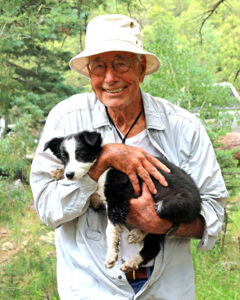Me and The River
 If you find the Tao (the Way, a river, a road) . . .cross it.
If you find the Tao (the Way, a river, a road) . . .cross it.I have lived most of my long life within 40 miles of the upper Rio Grande, working as a journalist in frenzied Santa Fe and retiring upstream in the quiet San Luis Valley. My little house is perched among piñon pines on an ancient moraine below the Sangre de Cristo mountains on the east side of the Valley, and the ragged profile of the San Juan Mountains is visible on he west side. The Rio Grande begins over there as a rivulet. Both the Continental Divide Trail and the Colorado Trail cross it without bridges. A dozen pretty rills flow from tarns in the north Sangre de Cristos to the Valley’s 5,000-square-mile ancient lake bed and sink into the aquifer. At the crest four summits register more than 14,000 feet above sea level. Adept climbers know them as Crestone Needle, Crestone Peak, Kit Carson Peak and Challenger high point. They are shown in the picture here that I took from the sister summit of Mount Adams.

The Rio drains the valley, drawing ground water from the Crestone group in the northwest and pouring onto the surface from San Juans on the southwest. In New Mexico the river cuts into a 700-feet-deep gorge crossed by a vertiginous bridge near Taos, and Santa Fe is on a 20-mile tributary. At flood-controlled Albuquerque in the center of the state, the upper river changes its name from Rio Arriba to Rio Abajo. The lower river meanders to Texas, where it encounters a mess of trouble and ceases to be a river of the West.
Santa Fe, on a 20-mile tributary, began as a Pueblo community among others attached to the upper Rio Grande. Now the state capital, Santa Fe was was occupied in 1598 by the Spanish conquistadors, who were repelled in the Pueblo Revolt of 1680, and returned in 1692. The Spanish colonizers, including Sephardic Jews fleeing persecution Santa Fe began a thousand years ago as one of the indigenous Pueblo communities dependent on the upper Rio Grande. The first Europeans were the conquistadors in 1598. The Spanish invaders were repelled in the Pueblo Revolt of 1680, but they regrouped in Mexico and returned in 1692. The colonizers, including Sephardic Jews fleeing persecution, were not kind to the Pueblo people, just as the hungering Anglo Americans, invading in 1846, were not kind to the Spanish. But the Rio Grande West is not the same as the horse-and-gun West, with its centuries of war rationalized on one side by Manifest Destiny and on the other by desperation to save a way of life in wild nature. The Pueblos actually did not use many horses (or for that matter, guns). And so Equus strays left behind by the Spanish during the Pueblo revolt began racing into horseless North America from Santa Fe, were not kind to the Pueblo people, just as the hungering Anglo Americans, invading in 1846, were not kind to the Spanish.
The river is the centerline of a cultural symmetry that kept me in Santa Fe for 35 years. Symmetry is not identity, and there was always cultural opposition bordering on racism. I myself could have been hit by an active shooter at the land-grant insurrection called The Courthouse Raid. But for me the less dangerous and most interesting fights were unarmed and subtle, rooted in interpretations of history, art and even music. I liked writing about the arguments. The state legislature also was a fascinating forum with a culture-clash backdrop. That and creative political corruption were job security for a news writer. Everything earned salvation through the holy spirit of accommodation and respect. This was the milieu that influenced my life and work in Santa Fe.
Of course, I did not escape the influence of my upbringing. Born in Wyoming, where my father worked in the oil patch. I grew up in south Denver, and was university-educated in Boulder. I entered journalism with United Press International in San Francisco, transferring adventurously to bureaus in Helena, Salt Lake, Topeka, Denver, and finally Santa Fe where I joined the Associated Press and settled down. I helped raise my two daughters under the flag of a failed marriage. On the basis of my 15-year record with the wire services I received a year-long journalism fellowship at Stanford. When I came back, I joined the Albuquerque Journal as its Santa Fe bureau chief, then founding editor of its Journal North zoned edition. I concluded my 20-year Journal career as a columnist for the paper, retiring at 62 to backpack, ski, write a novel and travel everywhere with Patricia Kvill. Now we are married, honeymoon first!
I received more education, getting an MA in Eastern Classics at St. John’s College Santa Fe. I have continued my dedication to Buddhism, which I first encountered as a young man in Thailand. This collection of reviews, reports, far-flung travelogs and histories is journalistic. I follow the old discarded style of writing the summarizing paragraph first, so you will know what the piece is going to be about.
And now it is time for a final edit, “The Summing Up,” as one traveling writer, Somerset Maugham, entitled what he thought would be his final book. He lived another 30 years. I will be happy with the few I have left.
—Larry Calloway
